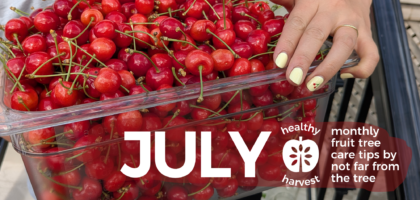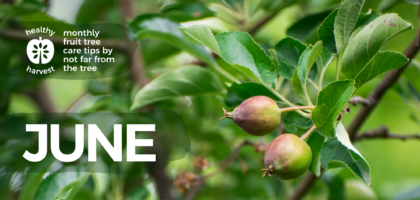
July Healthy Harvest Habits
Thinking about adding a new fruit tree to your garden? Most gardeners know about the more common fruits like apricots, plums, and cherries. But there is a lesser-known, native fruit tree that you can add to your garden (bonus: the leaves have compounds that deter squirrels!).
What Is Pawpaw?
Found in zones 5 to 8, pawpaws (Asimina triloba) are shrub-like, deciduous trees with oblong, glossy leaves. In summer, pawpaw trees produce burgundy-coloured fruit with curled petals and in fall, these trees produce the best product: the pawpaw fruit. The fruit itself is mango-shaped and yellow, with a custard-mango taste (pawpaws are related to more tropical soursop fruits, which have a similar flavour).
The History of Pawpaws
The pawpaw is the largest fruit native to North America, originally cultivated by Indigenous peoples in the Ohio River Valley. The Shawnee even had a whole calendar month dedicated to the pawpaw! The first European mention of pawpaws is from 1540, when an expedition to the Mississippi ended in the discovery of pawpaw cultivation. Apparently, even two US presidents enjoyed eating the fruit!
Pawpaws require well-draining soil and shelter from damaging winds (especially in Toronto). Additionally, young pawpaws require partial shade for the first few years, but this shade must be removed to provide full sun once the tree is established. The leaves are susceptible to fungal leaf spot, so be sure to plant the tree on a slope where moisture won’t collect.
In terms of choosing a tree, it is important to always buy a grafted tree from a reputable nursery and never take a chance on a seedling. Though seedlings are fun, there is often too much genetic variability to be sure if the tree will produce edible fruit. Additionally, pawpaw trees take a while to produce fruit, with grafted trees taking at least four or five years to even begin growing any fruit.
The fruit has a very short lifespan, so make sure to pick it as soon as it ripens and either use it or prepare the fruit for the freezer. Always make sure to separate the seeds, as they are mildly poisonous to humans.
Commercial Cultivation & The Future
Once a popular food source, the pawpaw has now been relegated to the sidelines of consumption. The fruit has a short ripening period in the fall and doesn’t ship very well, so options for commercial production are limited.
However, research across nine countries (and reports of experimental plantings across four more) has shown that commercial pawpaw orchards may exist in the near future! Kentucky State University has a whole pawpaw orchard, where they study crop genetics, diseases, fruit quality, and weather hardiness.
An additional use of pawpaw may be its bark: research has shown that pawpaw tree bark could be used to make an all-natural pesticide for commercial crops. So even if we never buy pawpaws at the grocery store, it will still have a positive impact on food security in the future!
Where To Buy
Don’t have space to grow pawpaw? No problem, just head to the Underpass Farmer’s Market in September to pick up a bag! Additionally, you can head to Muddy Farms to pick up pawpaw or other uncommon and freshly-picked fruits.
Written by: Frida Kitz
Sources:
Brannan, R. G., & Coyle, M. N. (2021). Worldwide Introduction of North American Pawpaw (Asimina triloba): Evidence Based on Scientific Reports. Sustainable Agriculture Research, 10(3), 1-19.
Alkofahi, A., Rupprecht, J. K., Anderson, J. E., Mclaughlin, J. L., Mikolajczak, K. L., & Scott, B. A. (1989). Search for new pesticides from higher plants. Insecticides of plant origin, 387, 25-43.

July Healthy Harvest Habits

June Healthy Harvest Habits